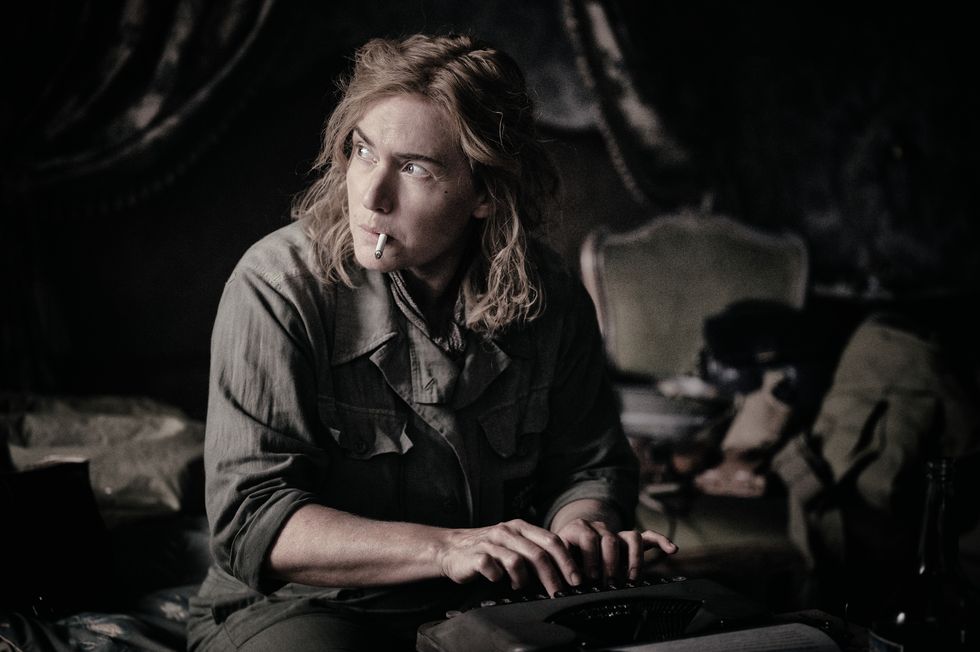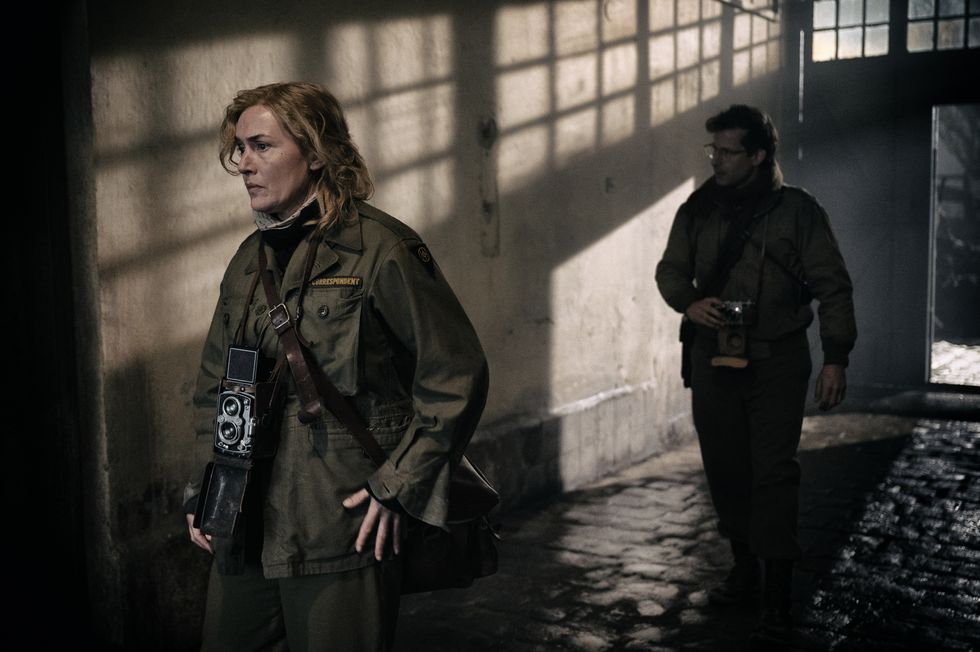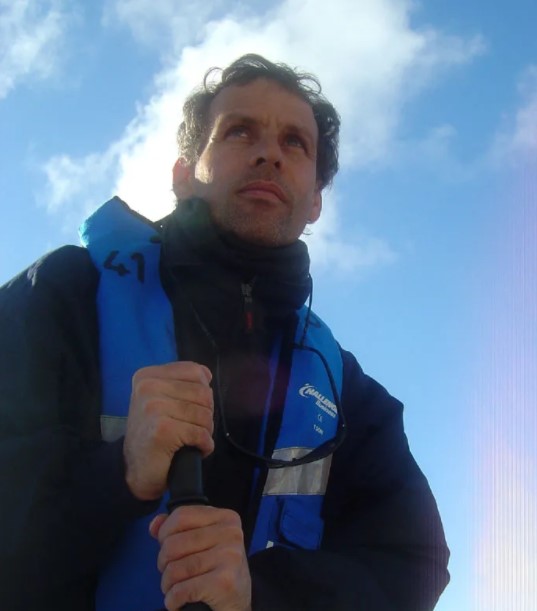What to Watch Verdict
Kate Winslet is in award-worthy form in this biopic of American-born fashion model turned World War Two photojournalist, but she's better than the film itself.
Pros
- +
Kate Winslet's powerful performance
- +
Harrowing depiction of war
- +
Visually distinctive
Cons
- -
Pedestrian script
- -
Leans too heavily on biopic tropes
Kate Winslet delivers an award-worthy performance in this biopic of American-born fashion model turned World War Two photojournalist Lee Miller, but she's better than the film itself. It's a great pity as Miller is more than deserving of biopic treatment and Winslet, the producer as well as star of Lee, has spent the best part of a decade bringing her story to the screen. A trailblazer in several different fields, Miller had already achieved distinction in the late 1920s and early 1930s as a high fashion model and Surrealist photographer before becoming a war correspondent. Her son Antony Penrose’s biography of his mother (the basis of the film) is aptly titled "The Lives of Lee Miller". It is the latter career, however, that is the focus of Lee, the directing debut of cinematographer Ellen Kuras, who previously worked with Winslet on Eternal Sunshine of the Spotless Mind and A Little Chaos.
Lee opens amid the confusion and peril of combat as Winslet's Miller dodges bullets and bombs, her chunky Rolleiflex camera slung around her neck. She is, we will learn, covering the siege of Saint-Malo in Brittany in August 1944, two months after the Allied D-Day invasion of northern France. The scene is a brief snapshot and we next see the older Miller in 1977, being interviewed about her life and career by a young journalist (Josh O’Connor) at her home in East Sussex, a framing device that is used, rather conventionally, to anchor the ensuing narrative.
Accompanied by Miller's seen-and-done-it-all voiceover, the film then backtracks to 1938 and the bohemian hedonism of Mougins in the south of France, where Miller is staying with a coterie of her fellow Surrealists, together with their lovers, friends and muses, including American artist Man Ray (Sean Duggan), French poet Paul Éluard (Vincent Colombe) and his wife Nusch (Noémie Merlant), and aristocratic fashion journalist Solange d’Ayen (Marion Cotillard).
At Mougins, Miller encounters her future husband, English Surrealist Roland Penrose (Alexander Skarsgård). Following a flirtatiously combative exchange in which they size each other up, it isn't long before the pair have hopped into bed. To remind us that late-1930s Europe isn't all about sun, sex and avant-garde art, the Mougins crowd are seen watching a newsreel showing Hitler among adoring crowds. They find it hard to understand how anyone could be taken in by the posturing Führer. Ever restless, Miller is meanwhile looking for a new role in life. "I’d been the model, the muse, the ingénue, but I was done with that," she says in another snippet of voice-over.
Skipping ahead we discover Miller and Penrose living in Blitz-battered London and both keen to do their bit for the war effort. Miller, a Quaker and pacifist, has agreed to work on developing military camouflage. He tries out his techniques on a semi-naked Miller, saying "If I can make you invisible, I can hide anything" (a version of something Penrose actually said and one of a number of real quotes the screenplay manages to elbow into the narrative). For her part, Miller encounters more difficulty finding a part to play but eventually gets taken on as a photographer for British Vogue by its formidable editor, Audrey Withers (Andrea Riseborough making the most of a small role). Also at work for Vogue, a snippy Cecil Beaton (Samuel Barnett) registers his disapproval with catty put-downs.

At this point any viewer familiar with Miller's work will be waiting for glimpses of some of her most famous photographs, and the film duly obliges by re-staging a number of iconic images — such as the pair of women in fire masks photographed sitting on the steps of Miller's own air-raid shelter in Hampstead in 1941. As diverting as these recreations are, they add little dramatic substance to the narrative, but the film steps up a gear after the dogged Miller overcomes the era's prevailing sexism and manages to get herself embedded with the US Army as a war correspondent for Vogue.
The screenplay continues to structure itself around Miller’s best known photographs, but as she crosses war-torn Europe, accompanied by her new friend and ally, Life magazine photojournalist David E Scherman (a sober role for American comedian Andy Samberg), the scenes increasingly gain in impact and power. An encounter with Cotillard’s traumatized Solange in her shattered Paris mansion gives Miller and us a glimpse of the horrors inflicted by the Nazis. Thousands of people are missing, Miller learns, including Solange’s husband.
The latest updates, reviews and unmissable series to watch and more!
The fate of many of Europe's missing is revealed when Miller and Scherman witness the liberation of Dachau concentration camp in a sequence of harrowing intensity, sensitively handled by Kuras and filmed in appropriately desaturated hues by cinematographer Pavel Edelman. The mud of Dachau still on their boots, Miller and Scherman then go to Hitler’s residence in Munich where Miller spontaneously takes a bath in the Führer's tub, an episode famously caught on camera by Scherman.
These later scenes are genuinely effective and affecting, which makes it even more of a shame that so much of the surrounding narrative is ploddingly pedestrian. It seems the screenwriters (four are credited) feel the need to hold the viewer’s hand at every step of the way. Indeed, the less you know about Miller and her work, and possibly the less you know about World War Two, the more successful the film will probably be. Yet even those completely unfamiliar with Miller will likely find the voice-over rote and redundant. We don’t need its explanatory nudging, or the lines of trite, on-the-nose dialogue. Winslet’s face conveys Miller’s pains and passions, traumas and triumphs on its own.
Lee will be shown in cinemas in the UK and Ireland from Friday, September 13, before it arrives on Sky Cinema a short while after. In the US Lee premieres in movie theaters on September 27.
A film critic for over 25 years, Jason admits the job can occasionally be glamorous – sitting on a film festival jury in Portugal; hanging out with Baz Luhrmann at the Chateau Marmont; chatting with Sigourney Weaver about The Archers – but he mostly spends his time in darkened rooms watching films. He’s also written theatre and opera reviews, two guide books on Rome, and competed in a race for Yachting World, whose great wheeze it was to send a seasick film critic to write about his time on the ocean waves. But Jason is happiest on dry land with a classic screwball comedy or Hitchcock thriller.


